Lexus ES 350 Navigation Manual
Introduction
This manual explains the operation of the Navigation System. Please read this manual carefully to ensure proper use. Keep this manual in your vehicle at all times.
The Navigation System is one of the most technologically advanced vehicle accessories ever developed. The system receives satellite signals from the Global Positioning System (GPS) operated by the U.S. Department of Defense. Using these signals and other vehicle sensors, the system indicates your present position and assists in locating a desired destination.
The navigation system is designed to select efficient routes from your present starting location to your destination. The system is also designed to direct you to a destination that is unfamiliar to you in an efficient manner. The system uses DENSO maps. The calculated routes may not be the shortest nor the least traffic congested. Your own personal local knowledge or “short cut” may at times be faster than the calculated routes.
The navigation system’s database includes Point of Interest categories to allow you to easily select destinations such as restaurants and hotels. If a destination is not in the database, you can enter the street address or a major intersection close to it and the system will guide you there.
The system will provide both a visual map and audio instructions. The audio instructions will announce the distance remaining and the direction to turn in approaching an intersection. These voice instructions will help you keep your eyes on the road and are timed to provide enough time to allow you to maneuver, change lanes or slow down.
1

Please be aware that all current vehicle navigation systems have certain limitations that may affect their ability to perform properly. The accuracy of the vehicle’s position depends on the satellite condition, road configuration, vehicle condition or other circumstances. For more information on the limitations of the system, refer to pages 370 through 371.
2
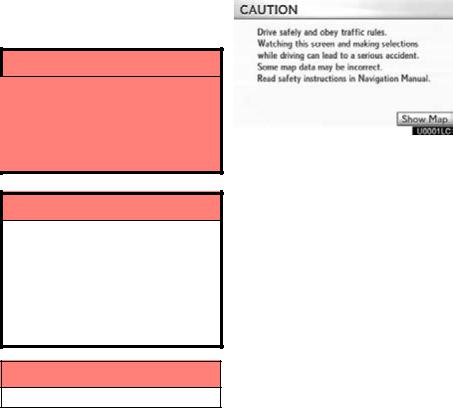
Important information about |
|
this manual |
Safety Instruction |
For safety reasons, this manual indicates items requiring particular attention with the following marks.
 CAUTION
CAUTION
This is a warning against anything which may cause injury to people if the warning is ignored. You are informed about what you must or must not do in order to reduce the risk of injury to yourself and others.
NOTICE
This is a warning against anything which may cause damage to the vehicle or its equipment if the warning is ignored. You are informed about what you must or must not do in order to avoid or reduce the risk of damage to your vehicle and its equipment.
INFORMATION
This provides additional information.
To use this system in the safest possible manner, follow all the safety tips shown below.
This system is intended to assist in reaching the destination and, if used properly, can do so. The driver is solely responsible for the safe operation of your vehicle and the safety of your passengers.
Do not use any feature of this system to the extent it becomes a distraction and prevents safe driving. The first priority while driving should always be the safe operation of the vehicle. While driving, be sure to observe all traffic regulations.
Prior to the actual use of this system, learn how to use it and become thoroughly familiar with it. Read the entire Navigation System Owner’s Manual to make sure you understand the system. Do not allow other people to use this system until they have read and understood the instructions in this manual.
For your safety, some functions may become inoperable when driving. Unavailable screen buttons are dimmed. Only when the vehicle is not moving, can the destination and route selection be done.
3
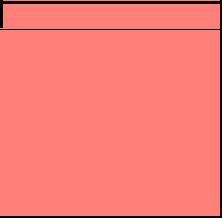
 CAUTION
CAUTION
DFor safety, the driver should not operate the navigation system while he/she is driving. Insufficient attention to the road and traffic may cause an accident.
DWhile driving, be sure to obey the traffic regulations and maintain awareness of the road conditions. If a traffic sign on the road has been changed, route guidance may not have the updated information such as the direction of a one way street.
While driving, listen to the voice instructions as much as possible and glance at the screen briefly and only when it is safe. However, do not totally rely on voice guidance. Use it just for reference. If the system cannot determine the current vehicle position correctly, there is a possibility of incorrect, late, or non−voice guidance.
The data in the system may occasionally be incomplete. Road conditions, including driving restrictions (no left turns, street closures, etc.) frequently change. Therefore, before following any instruction from the system, look to see whether the instruction can be done safely and legally.
This system cannot warn about such things as the safety of an area, condition of streets, and availability of emergency services. If unsure about the safety of an area, do not drive into it. Under no cir-
cumstances is this system a substitute for the driver’s personal judgement.
Use this system only in locations where it is legal to do so. Some states/provinces may have laws prohibiting the use of video and navigation screens next to the driver.
4

Table of Contents
Quick guide —
— Overview buttons and guidance screen . . . . . . . . . . . 10
— Registering home . . . . . . . . . . . . . . . . . . . . . . . . . . . . . . . . 12
— Registering preset destinations . . . . . . . . . . . . . . . . . . 14
— Operation flow: guiding the route . . . . . . . . . . . . . . . . . 16
— Setting home as the destination . . . . . . . . . . . . . . . . . . 17 Navigation system function index . . . . . . . . . . . . . . . . . . . 18 Quick reference (“Destination” screen) . . . . . . . . . . . . . . 20 Quick reference (“Setup” screen) . . . . . . . . . . . . . . . . . . . 22 Quick reference (“Information” screen) . . . . . . . . . . . . . . 23 1 Navigation System: Basic Functions
Basic information before operation
Initial screen . . . . . . . . . . . . . . . . . . . . . . . . . . . . . . . . . . . . . . . . . . . . . . . 26 Touch screen operation . . . . . . . . . . . . . . . . . . . . . . . . . . . . . . . . . . . . . 27 Inputting letters and numbers/List screen operation . . . . . . . . . . . . . 28 Screen adjustment . . . . . . . . . . . . . . . . . . . . . . . . . . . . . . . . . . . . . . . . . 31 Help icon . . . . . . . . . . . . . . . . . . . . . . . . . . . . . . . . . . . . . . . . . . . . . . . . . . 33 Map screen operation . . . . . . . . . . . . . . . . . . . . . . . . . . . . . . . . . . . . . . 33
Current position display . . . . . . . . . . . . . . . . . . . . . . . . . . . . . . . . . . 33 Screen scroll operation . . . . . . . . . . . . . . . . . . . . . . . . . . . . . . . . . . . 34 Switching the screens . . . . . . . . . . . . . . . . . . . . . . . . . . . . . . . . . . . . 39 Map scale . . . . . . . . . . . . . . . . . . . . . . . . . . . . . . . . . . . . . . . . . . . . . . 42 Foot print map . . . . . . . . . . . . . . . . . . . . . . . . . . . . . . . . . . . . . . . . . . 42 Orientation of the map . . . . . . . . . . . . . . . . . . . . . . . . . . . . . . . . . . . . 43 Standard map icons . . . . . . . . . . . . . . . . . . . . . . . . . . . . . . . . . . . . . . 44
Voice command system . . . . . . . . . . . . . . . . . . . . . . . . . . . . . . . . . . . . 44 Natural speech information . . . . . . . . . . . . . . . . . . . . . . . . . . . . . . . . 47 Command list . . . . . . . . . . . . . . . . . . . . . . . . . . . . . . . . . . . . . . . . . . . 49
Quick
Guide
Index
5
2 Navigation System: Destination Search
Destination search . . . . . . . . . . . . . . . . . . . . . . . . . . . . . . . . . . . . . . . . 62 Selecting the search area . . . . . . . . . . . . . . . . . . . . . . . . . . . . . . . . . 62 Destination search by Home . . . . . . . . . . . . . . . . . . . . . . . . . . . . . . 64 Destination search by Preset destinations . . . . . . . . . . . . . . . . . . . 64 Destination search by “Address” . . . . . . . . . . . . . . . . . . . . . . . . . . . 65 Destination search by “Point of Interest” . . . . . . . . . . . . . . . . . . . . 69 Destination search by “Destination Assist” . . . . . . . . . . . . . . . . . . 76 Destination search by “Previous Destinations” . . . . . . . . . . . . . . . 76 Destination search by “Address Book” . . . . . . . . . . . . . . . . . . . . . . 77 Destination search by “Emergency” . . . . . . . . . . . . . . . . . . . . . . . . 77 Destination search by “Intersection & Freeway” . . . . . . . . . . . . . . 78 Destination search by “Map” . . . . . . . . . . . . . . . . . . . . . . . . . . . . . . 81 Destination search by “Coordinates” . . . . . . . . . . . . . . . . . . . . . . . . 82 Deleting set destinations . . . . . . . . . . . . . . . . . . . . . . . . . . . . . . . . . . 82
Starting route guidance . . . . . . . . . . . . . . . . . . . . . . . . . . . . . . . . . . . . . . 83
3 Navigation System: Route Guidance
Route guidance screen . . . . . . . . . . . . . . . . . . . . . . . . . . . . . . . . . . . . . . 88 Typical voice guidance prompts . . . . . . . . . . . . . . . . . . . . . . . . . . . . . . 91 Distance and time to destination . . . . . . . . . . . . . . . . . . . . . . . . . . . . . . 93
Setting and deleting destinations . . . . . . . . . . . . . . . . . . . . . . . . . . . 94 Adding destinations . . . . . . . . . . . . . . . . . . . . . . . . . . . . . . . . . . . . . . 94 Reordering destinations . . . . . . . . . . . . . . . . . . . . . . . . . . . . . . . . . . 94 Deleting destinations . . . . . . . . . . . . . . . . . . . . . . . . . . . . . . . . . . . . . 95 Setting route . . . . . . . . . . . . . . . . . . . . . . . . . . . . . . . . . . . . . . . . . . . . . . 96 Detour setting . . . . . . . . . . . . . . . . . . . . . . . . . . . . . . . . . . . . . . . . . . . 96 Route overview . . . . . . . . . . . . . . . . . . . . . . . . . . . . . . . . . . . . . . . . . . 97 Route preference . . . . . . . . . . . . . . . . . . . . . . . . . . . . . . . . . . . . . . . . 99 Pausing and resuming guidance . . . . . . . . . . . . . . . . . . . . . . . . . 101
Show on map . . . . . . . . . . . . . . . . . . . . . . . . . . . . . . . . . . . . . . . . . . . 102 Display POI icons . . . . . . . . . . . . . . . . . . . . . . . . . . . . . . . . . . . . . 102
Route trace . . . . . . . . . . . . . . . . . . . . . . . . . . . . . . . . . . . . . . . . . . . 106
: Point of Interest
6
4 Navigation System: Memory Points
Navigation settings . . . . . . . . . . . . . . . . . . . . . . . . . . . . . . . . . . . . . . . 110 Setting up the “Home” . . . . . . . . . . . . . . . . . . . . . . . . . . . . . . . . . . . 111 Setting up the “Preset Destinations” . . . . . . . . . . . . . . . . . . . . . . . 113 Setting up the “Address Book” . . . . . . . . . . . . . . . . . . . . . . . . . . . . 116 Setting up the “Areas to Avoid” . . . . . . . . . . . . . . . . . . . . . . . . . . 122 Deleting previous destinations . . . . . . . . . . . . . . . . . . . . . . . . . . . 127
5 Telephone and Information
Telephone (Hands−free system for cellular phone) . . . . . . . . . 130 Enter a Bluetoothr phone . . . . . . . . . . . . . . . . . . . . . . . . . . . . . . . 134 Call on the Bluetoothr phone . . . . . . . . . . . . . . . . . . . . . . . . . . . . 139 Receive on the Bluetoothr phone . . . . . . . . . . . . . . . . . . . . . . . . 146 Talk on the Bluetoothr phone . . . . . . . . . . . . . . . . . . . . . . . . . . . . 146
Calendar . . . . . . . . . . . . . . . . . . . . . . . . . . . . . . . . . . . . . . . . . . . . . . . . 149
6 Lexus Enform with Safety Connect
Lexus Enform with Safety Connect−Overview . . . . . . . . . . . . . . . . 152 Destination Assist . . . . . . . . . . . . . . . . . . . . . . . . . . . . . . . . . . . . . . . . 155 eDestination . . . . . . . . . . . . . . . . . . . . . . . . . . . . . . . . . . . . . . . . . . . . . 158 XMr Sports and Stocks . . . . . . . . . . . . . . . . . . . . . . . . . . . . . . . . . . . 161 XM NavWeathert . . . . . . . . . . . . . . . . . . . . . . . . . . . . . . . . . . . . . . . . 166 XMr NavTraffic . . . . . . . . . . . . . . . . . . . . . . . . . . . . . . . . . . . . . . . . . . 170 Lexus Insider . . . . . . . . . . . . . . . . . . . . . . . . . . . . . . . . . . . . . . . . . . . . 173
7 Audio/video System
Quick reference . . . . . . . . . . . . . . . . . . . . . . . . . . . . . . . . . . . . . . . . . . 180 Using your audio/video system . . . . . . . . . . . . . . . . . . . . . . . . . . . 185 Some basics . . . . . . . . . . . . . . . . . . . . . . . . . . . . . . . . . . . . . . . . . . 185 Radio operation . . . . . . . . . . . . . . . . . . . . . . . . . . . . . . . . . . . . . . . 193 Radio operation (XMr Satellite Radio broadcast) . . . . . . . . . . . 198 CD changer operation . . . . . . . . . . . . . . . . . . . . . . . . . . . . . . . . . . 204 DVD changer operation . . . . . . . . . . . . . . . . . . . . . . . . . . . . . . . . 218 Bluetoothr audio operation . . . . . . . . . . . . . . . . . . . . . . . . . . . . . . 243 USB memory/iPod operation . . . . . . . . . . . . . . . . . . . . . . . . . . . . 251 Audio/video remote controls (steering switches) . . . . . . . . . . . . . . 258 Audio/video system operating hints . . . . . . . . . . . . . . . . . . . . . . . . . 260
7
8 |
Air Conditioning |
|
|
Automatic air conditioning controls . . . . . . . . . . . . . . . . . . . . . . . . . . |
270 |
9 |
Rear View Monitor System |
|
|
Rear view monitor system . . . . . . . . . . . . . . . . . . . . . . . . . . . . . . . . . |
280 |
10 |
Intuitive Parking Assist |
|
|
Intuitive parking assist . . . . . . . . . . . . . . . . . . . . . . . . . . . . . . . . . . . . |
286 |
11 |
Setup |
|
|
General settings . . . . . . . . . . . . . . . . . . . . . . . . . . . . . . . . . . . . . . . . . . |
294 |
|
Clock settings . . . . . . . . . . . . . . . . . . . . . . . . . . . . . . . . . . . . . . . . . . . . |
298 |
|
Voice settings . . . . . . . . . . . . . . . . . . . . . . . . . . . . . . . . . . . . . . . . . . . . |
300 |
|
Navigation settings . . . . . . . . . . . . . . . . . . . . . . . . . . . . . . . . . . . . . . . |
303 |
|
Detailed navigation settings . . . . . . . . . . . . . . . . . . . . . . . . . . . . . . . . |
303 |
|
Telephone settings . . . . . . . . . . . . . . . . . . . . . . . . . . . . . . . . . . . . . . |
312 |
|
Volume setting . . . . . . . . . . . . . . . . . . . . . . . . . . . . . . . . . . . . . . . . |
313 |
|
Manage phone . . . . . . . . . . . . . . . . . . . . . . . . . . . . . . . . . . . . . . . . |
314 |
|
Phonebook . . . . . . . . . . . . . . . . . . . . . . . . . . . . . . . . . . . . . . . . . . . |
322 |
|
Setting the phonebook . . . . . . . . . . . . . . . . . . . . . . . . . . . . . . . . . |
323 |
|
Speed dials setting . . . . . . . . . . . . . . . . . . . . . . . . . . . . . . . . . . . . |
331 |
|
Deleting call history . . . . . . . . . . . . . . . . . . . . . . . . . . . . . . . . . . . . |
338 |
|
Setting the voice tag . . . . . . . . . . . . . . . . . . . . . . . . . . . . . . . . . . . |
339 |
|
Bluetoothr . . . . . . . . . . . . . . . . . . . . . . . . . . . . . . . . . . . . . . . . . . . . |
343 |
|
Details . . . . . . . . . . . . . . . . . . . . . . . . . . . . . . . . . . . . . . . . . . . . . . . |
348 |
|
Audio settings . . . . . . . . . . . . . . . . . . . . . . . . . . . . . . . . . . . . . . . . . . |
351 |
|
Select portable player . . . . . . . . . . . . . . . . . . . . . . . . . . . . . . . . . . |
351 |
|
Setting Bluetoothr audio . . . . . . . . . . . . . . . . . . . . . . . . . . . . . . . . |
353 |
|
Vehicle settings . . . . . . . . . . . . . . . . . . . . . . . . . . . . . . . . . . . . . . . . . |
358 |
|
Maintenance . . . . . . . . . . . . . . . . . . . . . . . . . . . . . . . . . . . . . . . . . . |
358 |
|
Vehicle customization . . . . . . . . . . . . . . . . . . . . . . . . . . . . . . . . . . |
363 |
|
Intuitive parking assist setting . . . . . . . . . . . . . . . . . . . . . . . . . . . |
364 |
|
Other settings . . . . . . . . . . . . . . . . . . . . . . . . . . . . . . . . . . . . . . . . . . . . |
366 |
12 |
Appendix |
|
|
Limitations of the navigation system . . . . . . . . . . . . . . . . . . . . . . . . . |
370 |
|
Map database information and updates . . . . . . . . . . . . . . . . . . . . . . |
372 |
Index . . . . . . . . . . . . . . . . . . . . . . . . . . . . . . . . . . . . . . . . . . . . . 383
8
9
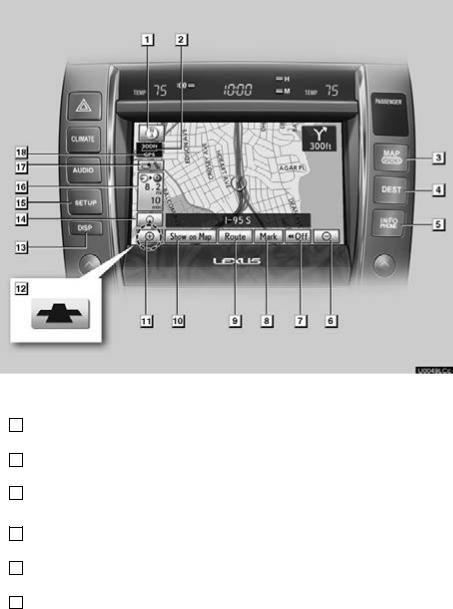
Quick guide —
— Overview buttons and guidance screen
No. |
Name |
Function |
Page |
|
|
North−up or |
This symbol indicates a map view with |
|
|
1 |
heading−up |
north−up or heading−up. Touching this |
43 |
|
|
symbol |
symbol changes the map orientation. |
|
|
|
|
|
|
|
2 |
Scale indicator |
This figure indicates the map scale. |
42 |
|
|
|
|
|
|
|
“MAP/VOICE” |
Push this button to repeat a guidance |
|
|
3 |
voice, cancel the map scroll, start guid- |
33 |
||
button |
||||
|
ance and display the current position. |
|
||
|
|
|
||
|
|
|
|
|
4 |
“DEST” button |
Push this button to display the “Destina- |
12, 14, 16, 17, |
|
tion” screen. |
20, 62 |
|||
|
|
|||
|
|
|
|
|
5 |
“INFO/PHONE” |
Push this button to display the “Informa- |
23, 134, 149, |
|
button |
tion” screen. |
167, 381 |
||
|
||||
|
|
|
|
|
6 |
Zoom out button |
Touch this button to reduce the map |
42 |
|
scale. |
||||
|
|
|
||
|
|
|
|
10

No. |
Name |
Function |
Page |
|
|
|
Touch this button to obtain a broader |
|
|
7 |
“AAOff” |
view. Some of the buttons on the screen |
309 |
|
are not displayed. They are displayed |
||||
|
|
|
||
|
|
again by touching “On""”. |
|
|
|
|
|
|
|
|
“Mark” |
Touch this button to register the current |
|
|
8 |
position or the cursor position as an ad- |
35 |
||
|
|
dress book entry. |
|
|
|
|
|
|
|
9 |
“Route” |
Touch this button to change the route. |
94, 96 |
|
|
|
|
|
|
|
|
Touch this button to browse information |
|
|
10 |
“Show on Map” |
about guidance route, to set the Points |
102, 170 |
|
of Interest to be displayed on the |
||||
|
|
|
||
|
|
screen, or to record the route. |
|
|
|
|
|
|
|
11 |
Zoom in button |
Touch this button to magnify the map |
42 |
|
scale. |
||||
|
|
|
||
|
|
|
|
|
12 |
Foot print map |
Touch this button to display the foot print |
42 |
|
button |
map and the building information. |
|||
|
|
|||
|
|
|
|
|
13 |
“DISP” button |
Push this button to display the “Display” |
31 |
|
(quality control) screen. |
||||
|
|
|
||
|
|
|
|
|
|
Screen |
Touch this button to change the screen |
|
|
14 |
configuration |
39 |
||
mode. |
||||
|
button |
|
||
|
|
|
||
|
|
|
|
|
|
“SETUP” button |
Push this button to display the “Setup” |
22, 110, 294, |
|
15 |
298, 300, 303, |
|||
screen. |
||||
|
|
312, 351, 358 |
||
|
|
|
||
|
|
|
|
|
16 |
Distance and time |
Displays the distance, the estimated |
93 |
|
to destination |
travel time to the destination, and the |
|||
|
estimated arrival time at the destination. |
|
||
|
|
|
||
|
|
|
|
|
17 |
XMr indicator |
This mark is displayed when XMr infor- |
166, 170 |
|
mation is received. |
||||
|
|
|
||
|
|
|
|
|
|
“GPS” mark |
Whenever the vehicle is receiving sig- |
|
|
|
(Global |
|
||
18 |
nals from the GPS, this mark is dis- |
370 |
||
Positioning |
||||
|
played. |
|
||
|
System) |
|
||
|
|
|
||
|
|
|
|
11

— Registering home
1 Push the “DEST” button.
2 Touch “Go Home”.
If home has not been registered, you can register it by touching “Go Home”.
3 Touch “Yes”.
4 There are 4 different methods to search your home.
See “Destination search” on page 62.
12
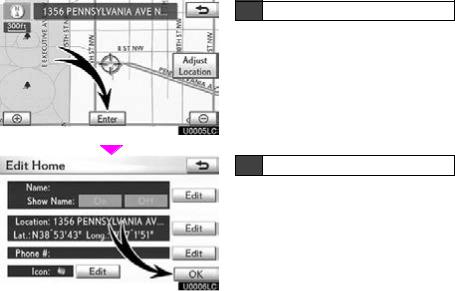
5 Touch “Enter”.
The “Edit Home” screen is displayed.
6 Touch “OK”.
Registration of home is complete.
You can also register home by pushing the “SETUP” button. (See “ (a) Registering home” on page 111.)
You can change the name, location, phone number and icon. (See “ (b) Editing home” on page 112.)
13
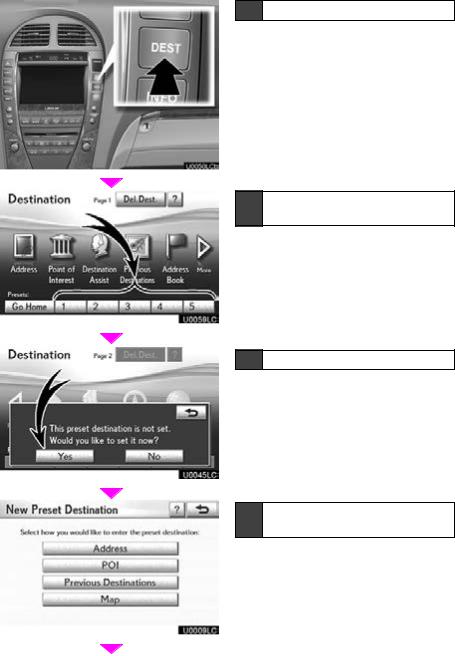
— Registering preset destinations
1 Push the “DEST” button.
2 Touch one of the preset destination buttons.
You can set a preset destination to any preset destination button that has not yet been set.
3 Touch “Yes”.
4 There are 4 different methods to search preset destinations.
See “Destination search” on page 62.
14
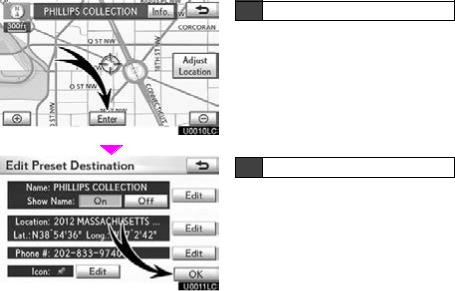
5 Touch “Enter”.
The “Edit Preset Destination” screen is displayed.
6 Touch “OK”.
Registration of preset destinations is complete.
You can also register preset destinations by pushing the “SETUP” button.
(See “ (a) Registering preset destinations” on page 114.)
You can change the name, location, phone number and icon. (See “ (b) Editing preset destinations” on page 115.)
The registered points can be used on the “Destination” screen. (See “ — Destination search by Preset destinations” on page 64.)
15
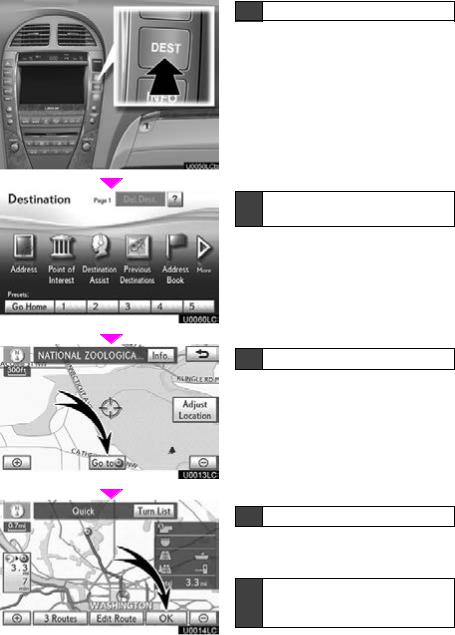
— Operation flow: guiding the route
1 Push the “DEST” button.
2 There are 11 different methods to search destinations.
See “Destination search” on page 62.
3 Touch “Go to  ”.
”.
The navigation system performs a search for the route.
4 Touch “OK”, and start driving.
Routes other than the one recommended can also be selected. (See “Starting route guidance” on page 83.)
5 Guidance to the destination is given via voice and on the guidance screen.
16
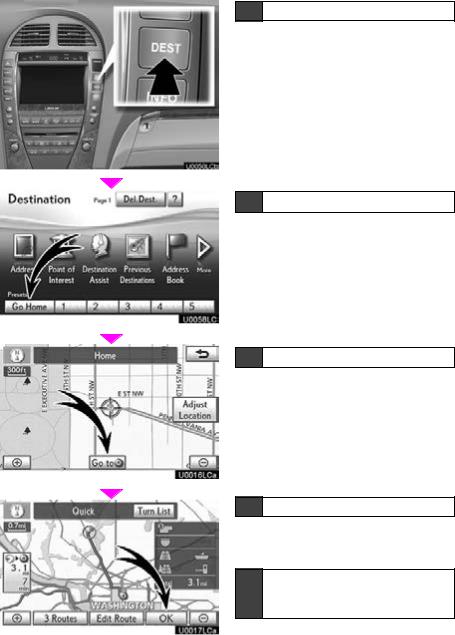
— Setting home as the destination
1 Push the “DEST” button.
2 Touch “Go Home”.
“Go Home” can be used if your home has been registered. (To register “Home”, see “ (a) Registering home” on page 111.)
3 Touch “Go to  ”.
”.
The navigation system performs a search for the route.
4 Touch “OK”, and start driving.
Routes other than the one recommended can also be selected. (See “Starting route guidance” on page 83.)
5 Guidance to the destination is given via voice and on the guidance screen.
17

Navigation system function index
hMapi
Displaying maps |
Page |
Viewing the map screen |
10 |
|
|
Displaying the current vehicle position |
33 |
|
|
Viewing the current position vicinity map |
34 |
|
|
Changing the scale |
42 |
|
|
Changing the map orientation |
43 |
|
|
Displaying Point of Interest |
102 |
|
|
Displaying the estimated travel/arrival time to the destination |
93 |
|
|
Selecting the dual map screen |
39 |
|
|
Viewing foot print map |
42 |
|
|
Deleting map screen buttons |
309 |
Searching destination |
Page |
|
Searching the destination |
62 |
|
(by home, Point of Interest, phone #, etc.) |
||
|
||
|
|
|
Changing the selected search area |
62 |
|
|
|
|
Operating the map location of the selected destination |
83 |
hRoute guidancei
Before starting route guidance |
Page |
Setting the destination |
83 |
|
|
Viewing alternative routes |
83 |
|
|
Starting route guidance |
83 |
Before starting or during route guidance |
Page |
Viewing the route |
83 |
|
|
Adding destinations |
94 |
|
|
Changing the route |
96 |
|
|
Displaying the estimated travel/arrival time to the destination |
93 |
18
During route guidance |
Page |
Pausing route guidance |
101 |
|
|
Adjusting route guidance volume |
301 |
|
|
Deleting the destination |
82, 95 |
|
|
Displaying the entire route map |
97 |
|
|
hUseful functionsi
Address book |
Page |
Registering your own address book entries |
116 |
|
|
Marking icons on the map |
118 |
Information |
Page |
Displaying vehicle maintenance |
358 |
|
|
Displaying the calendar |
149 |
Hands−free system (for cellular phone) |
Page |
Initiating Bluetoothr |
134 |
|
|
Making a call on the Bluetoothr phone |
139 |
|
|
Receiving a call on the Bluetoothr phone |
146 |
Voice command system |
Page |
Operating the system with your voice |
44 |
|
|
19
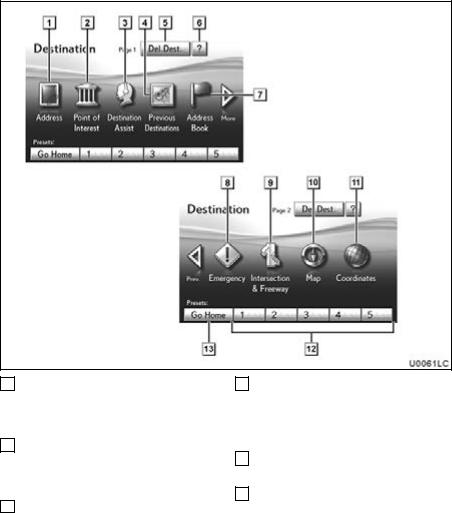
Quick reference (“Destination” screen)
The “Destination” screen allows you to search for a destination. To display the “Destination” screen, push the “DEST” button.
1 |
“Address” |
4 |
“Previous Destinations” |
|
A house number and the street address |
A destination can be selected from any of |
|||
can be input by using the input keys. |
the last 100 previously set destinations |
|||
. . . . |
. . . . . . . . . . . . . . . . . . . . . . . . . . . . . 65 |
and from the previous starting point. |
76 |
|
2 |
“Point of Interest” |
. . . . |
. . . . . . . . . . . . . . . . . . . . . . . . . . . . . |
|
5 |
“Del. Dest.” |
|
||
Select one of the many Points of Interest |
|
|||
|
|
|
||
that have already been stored in the sys- |
Set destinations can be deleted. . . . . |
82 |
||
tem’s database. . . . . . . . . . . . . . . . . . . 69 |
6 |
“?” |
|
|
|
|
|
||
3 “Destination Assist”
Provides you with live assistance finding destinations via the Lexus Enform response center. . . . . . . . . . . . . . . . . . . 155
Function help for the “Destination” screen can be viewed on this screen. . . . . . . 33
20

7 “Address Book”
The desired location can be selected from a registered entry in the “Address book”. (To register address book entries, see “(a) Registering address book entries” on page 117.) . . . . . . . . . . . . . . . . . . . . . . . . . . . . 77
8 “Emergency”
One of the four categories of emergency service points that are already stored in the system’s database can be selected.
. . . . . . . . . . . . . . . . . . . . . . . . . . . . . . . . . 77
9 “Intersection & Freeway”
The names of two intersecting streets or a freeway (interstate) entrance or exit can be entered. This is helpful if only the general vicinity, not the specific address, is known.
. . . . . . . . . . . . . . . . . . . . . . . . . . . . . . . . . 78
10 “Map”
A destination can be selected simply by touching the location on the displayed map. . . . . . . . . . . . . . . . . . . . . . . . . . . . . 81
11 “Coordinates”
A destination can be set using latitudes and longitudes as coordinates. . . . . . 82
12 Preset destination buttons
One of 5 preset destination points can be selected by touching the screen directly. If a preset destination point has not been registered, a message will be displayed and the setting screen will automatically appear. To use this function, it is necessary to set the “preset destination”. (To register a “Preset Destination”, see “(a) Registering preset destinations” on page 114.) . . . . . . . . . . . . . . . . . . . . . . . . . . . . 64
13 “Go Home”
A personal home address can be selected without entering the address each time. If “Home” has not been registered, a message will be displayed and the setting screen will automatically appear. To use this function, it is necessary to set a “Home” address. (To register “Home”, see “(a) Registering home” on page 111.)
. . . . . . . . . . . . . . . . . . . . . . . . . . . . . . . . . 64
21
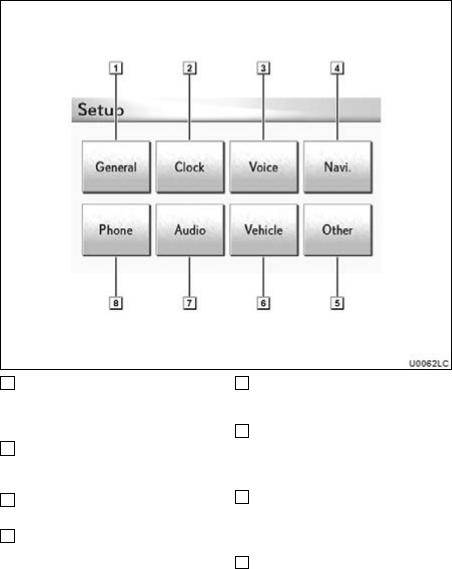
Quick reference (“Setup” screen)
The items shown on the “Setup” screen can be set. To display the “Setup” screen, push the “SETUP” button.
1 “General”
Settings are available for language selection, operation sounds, automatic screen change, etc. . . . . . . . . . . . . . . . . . . . . 294
2 “Clock”
Used for changing settings for time zones, daylight saving time, etc. . . . . . . . . . . 298
3 “Voice”
Voice guidance can be set. . . . . . . . 300
4 “Navi.”
Settings are available for average cruising speed, displayed screen contents, POI icon categories, etc. . . . . . . . . . . . . . . 303
5 “Other”
Settings are available for Lexus Insider, XMr Sports and Stocks. . . . . . . . . . . 366
6 “Vehicle”
Settings are available for vehicle information such as maintenance information.
. . . . . . . . . . . . . . . . . . . . . . . . . . . . . . . . 358
7 “Audio”
Settings are available for portable audio devices, Bluetoothr audio devices etc.
. . . . . . . . . . . . . . . . . . . . . . . . . . . . . . . . 351
8 “Phone”
Bluetoothr phones and phone numbers can be registered, and the receiver volume can be adjusted. . . . . . . . . . . . . . . . . . 312
22
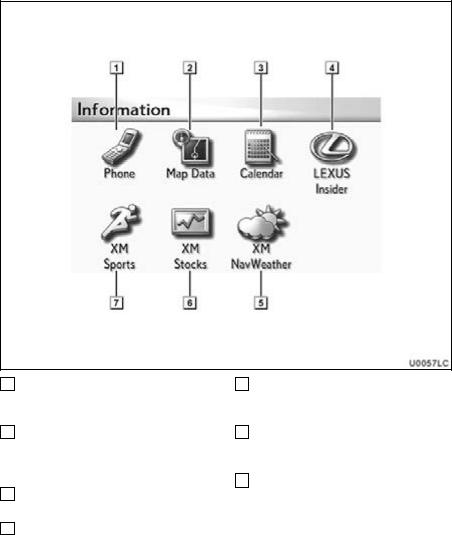
Quick reference (“Information” screen)
This screen can be used to display the calendar and information on operation of the hands−free phone, etc. To display the “Information” screen, push the “INFO/PHONE” button.
1 “Phone”
To view hands free phone information.
. . . . . . . . . . . . . . . . . . . . . . . . . . . . . . . . 134
2 “Map Data”
Displays information regarding the map data disc version or coverage area.
. . . . . . . . . . . . . . . . . . . . . . . . . . . . . . . . 381
3 “Calendar”
To view calendar. . . . . . . . . . . . . . . . . 149
4 “LEXUS Insider”
To display the “LEXUS Insider” screen.
. . . . . . . . . . . . . . . . . . . . . . . . . . . . . . . . 173
5 “XM NavWeather”
To display the “XM NavWeather” screen.
. . . . . . . . . . . . . . . . . . . . . . . . . . . . . . . . 166
6 “XM Stocks”
To display the “XM Stocks” screen.
. . . . . . . . . . . . . . . . . . . . . . . . . . . . . . . . 161
7 “XM Sports”
To display the “XM Sports” screen.
. . . . . . . . . . . . . . . . . . . . . . . . . . . . . . . . 161
23
24

NAVIGATION SYSTEM: BASIC FUNCTIONS
SECTION 1
NAVIGATION SYSTEM:
BASIC FUNCTIONS
Basic information before operation
D Initial screen . . . . . . . . . . . . . . . . . . . . . . . . . . . . . . . . . . . . . . . . . . . 26
D Touch screen operation . . . . . . . . . . . . . . . . . . . . . . . . . . . . . . . . . |
27 |
D Inputting letters and numbers/List screen operation . . . . . . . . . 28
D Screen adjustment . . . . . . . . . . . . . . . . . . . . . . . . . . . . . . . . . . . . . |
31 |
D Help icon . . . . . . . . . . . . . . . . . . . . . . . . . . . . . . . . . . . . . . . . . . . . . . 33
D Map screen operation . . . . . . . . . . . . . . . . . . . . . . . . . . . . . . . . . 33 Current position display . . . . . . . . . . . . . . . . . . . . . . . . . . . . . . . 33 Screen scroll operation . . . . . . . . . . . . . . . . . . . . . . . . . . . . . . . 34 Switching the screens . . . . . . . . . . . . . . . . . . . . . . . . . . . . . . . . . 39 Map scale . . . . . . . . . . . . . . . . . . . . . . . . . . . . . . . . . . . . . . . . . . . 42 Foot print map . . . . . . . . . . . . . . . . . . . . . . . . . . . . . . . . . . . . . . . 42 Orientation of the map . . . . . . . . . . . . . . . . . . . . . . . . . . . . . . . . 43 Standard map icons . . . . . . . . . . . . . . . . . . . . . . . . . . . . . . . . . . 44
D Voice command system . . . . . . . . . . . . . . . . . . . . . . . . . . . . . . . 44 Natural speech information . . . . . . . . . . . . . . . . . . . . . . . . . . . . 47 Command list . . . . . . . . . . . . . . . . . . . . . . . . . . . . . . . . . . . . . . . . 49
25
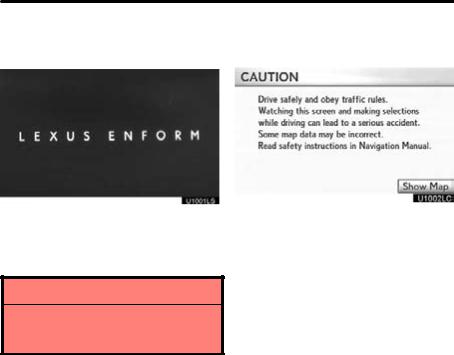
NAVIGATION SYSTEM: BASIC FUNCTIONS
Initial screen
When the “ENGINE START STOP” switch is in ACCESSORY or IGNITION ON mode, the initial screen will be displayed and the system will begin operating.
 CAUTION
CAUTION
When the vehicle is stopped with the engine running, always apply the parking brake for safety.
After a few seconds, the “CAUTION” screen will be displayed.
After about 5 seconds, the “CAUTION” screen automatically switches to the map screen. When touching “Show Map” or pushing the “MAP/VOICE” button, the map screen is displayed.
While the “CAUTION” screen is displayed, the “DEST” or “SETUP” button cannot be operated. And if the “Calendar” button on the “Information” screen is touched, the screen will change back to the “CAUTION” screen. In about 5 seconds, or when the “MAP/VOICE” button is pushed or the “Show Map” is touched, the “CAUTION” screen will change to the map screen.
26
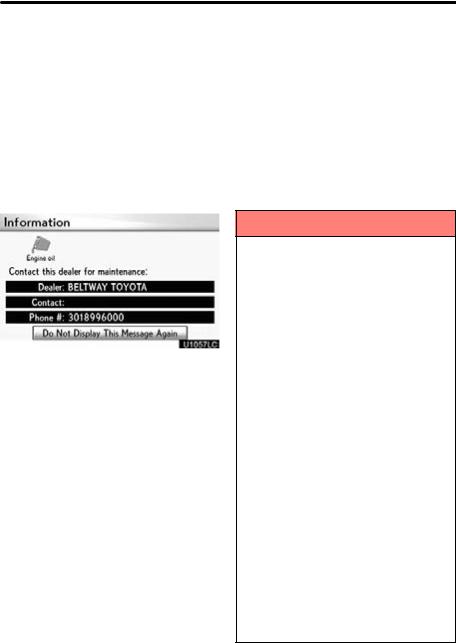
NAVIGATION SYSTEM: BASIC FUNCTIONS
D Maintenance information
This system informs about when to replace certain parts or components and shows dealer information (if registered) on the screen.
When the vehicle reaches a previously set driving distance or date specified for a scheduled maintenance check, the “Information” screen will be displayed when the navigation system is in operation.
Touch screen operation
This system is operated mainly by the touch screen buttons on the screen.
To prevent damage to the screen, lightly touch buttons on the screen with the finger. When a button on the screen is touched, a beep sounds. (To set a beep sound, see page 294.)
Do not use objects other than the finger to touch the screen.
To disable this screen, touch “Do Not Display This Message Again”. This screen goes off if the screen is not operated for several seconds.
To prevent this information screen from being displayed again, touch “Do Not
Display This Message Again”.
To register “Maintenance information”, see “—Maintenance” on page 358.
INFORMATION
DIf the system does not respond to a touch on a touch screen button, move the finger away from the screen and then touch it again.
DDimmed touch screen buttons cannot be operated.
DWipe off fingerprints using a glass cleaning cloth. Do not use chemical cleaners to clean the touch screen.
DThe displayed image may become darker and moving images may be slightly distorted when the display is cold.
DUnder extremely cold conditions, the map may not be displayed and the data input by a user may be deleted. Also, the touch screen buttons may be harder than usual to depress.
DWhen you look at the screen through polarized material such as polarized sunglasses, the screen may be dark and hard to see. If so, look at the screen from different angles, adjust the screen settings on the “Display” screen, or take off your sunglasses.
27
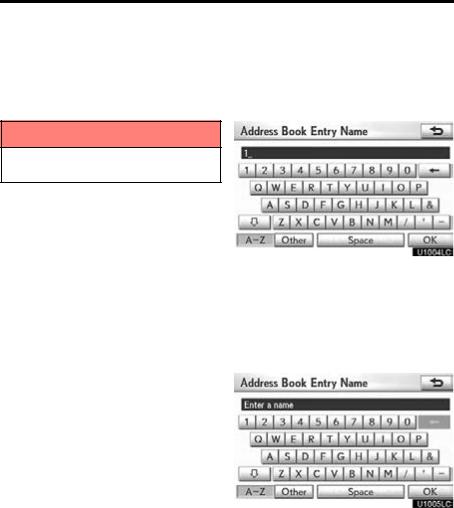
NAVIGATION SYSTEM: BASIC FUNCTIONS
Inputting letters and numbers/List screen operation
When searching for an address or a name, or entering, letters and numbers can be input via the screen.
D To input letters and numbers
To display the alphabet keys, touch
“A−Z”.
INFORMATION
Keyboard layout can be changed. (See page 296.)
Enter letters by touching the keys directly.
 : Touching this button erases one
: Touching this button erases one
letter. By holding this button, letters will continue to be erased.
On certain letter entry screens, letters can be entered in upper or lower case.
 : To enter in lower case.
: To enter in lower case.
 : To enter in upper case.
: To enter in upper case.
28
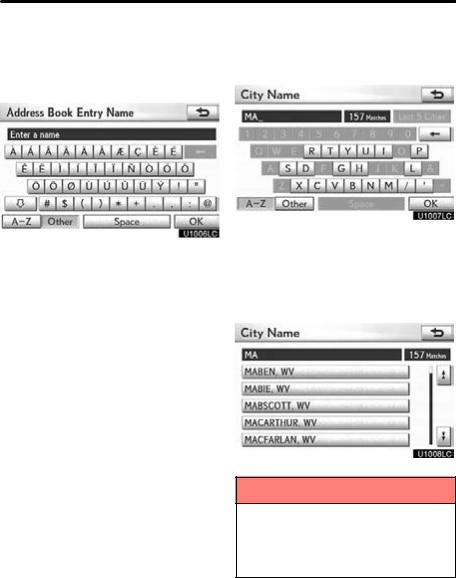
NAVIGATION SYSTEM: BASIC FUNCTIONS
D To input symbols |
D To display the list |
To display symbol keys, touch “Other”. |
|
Enter symbols by touching the symbol keys directly.
 : Touching this button erases one
: Touching this button erases one
letter. By holding this button, letters will continue to be erased.
To search for an address or a name, touch “OK”. Matching items from the database are listed even if the entered address or name is incomplete.
If the number of matches is five or less, the list is displayed without touching “OK”.
INFORMATION
The number of matching items is shown to the right side of the screen. If the number of matching items is more than 999, the system displays “ ” on the screen.
29
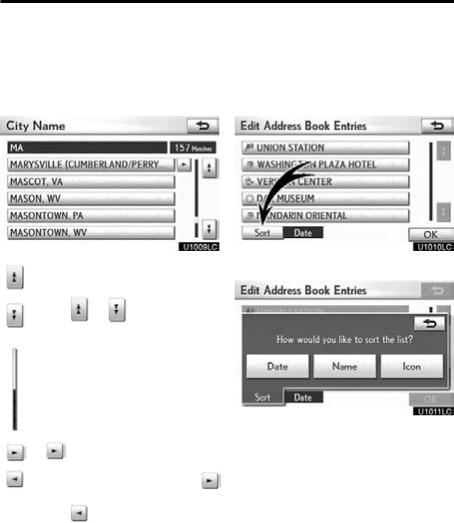
NAVIGATION SYSTEM: BASIC FUNCTIONS
D List screen operation
When a list is displayed, use the appropriate button to scroll through the list.
To shift to the next or previous page.
Touch |
or |
to scroll through |
the displayed list.
This expresses a displayed screen position.
If |
appears to the right of the |
item name, the complete name is too long for the display. Touch to scroll to the end of the name.
Touch |
to scroll to the beginning |
of the name.
D Sorting
The order of a list displayed on the screen can be rearranged.
1. Touch “Sort”.
2. Touch the desired sorting criteria.
Sorting criteria are as follows:
“Distance”: To sort in the order of distance from your current location.
“Date”: To sort in the order of the date.
“Category”: To sort in the order of the category.
“Icon”: To sort in the order of the icons. “Name”: To sort in order by name.
30
